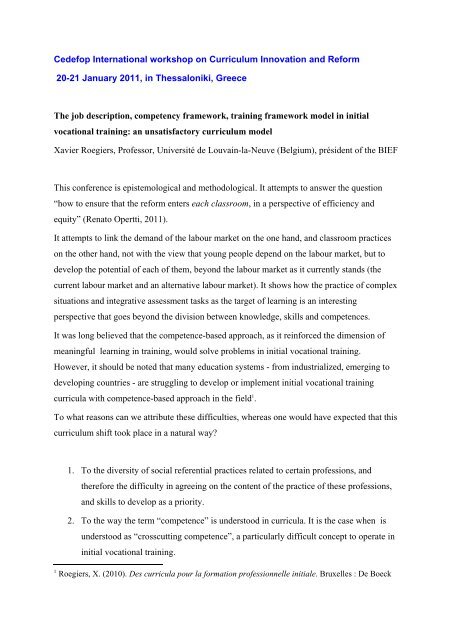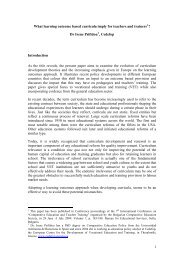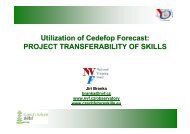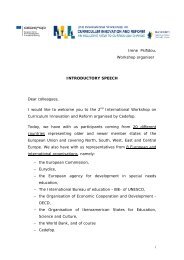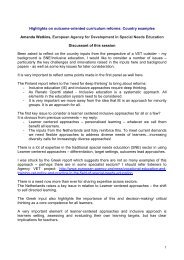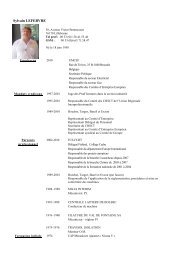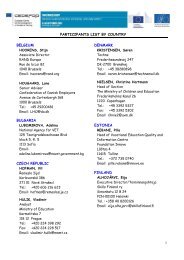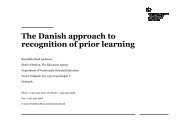The job description, competency framework, training framework ...
The job description, competency framework, training framework ...
The job description, competency framework, training framework ...
Create successful ePaper yourself
Turn your PDF publications into a flip-book with our unique Google optimized e-Paper software.
Cedefop International workshop on Curriculum Innovation and Reform<br />
20-21 January 2011, in <strong>The</strong>ssaloniki, Greece<br />
<strong>The</strong> <strong>job</strong> <strong>description</strong>, <strong>competency</strong> <strong>framework</strong>, <strong>training</strong> <strong>framework</strong> model in initial<br />
vocational <strong>training</strong>: an unsatisfactory curriculum model<br />
Xavier Roegiers, Professor, Université de Louvain-la-Neuve (Belgium), président of the BIEF<br />
This conference is epistemological and methodological. It attempts to answer the question<br />
“how to ensure that the reform enters each classroom, in a perspective of efficiency and<br />
equity” (Renato Opertti, 2011).<br />
It attempts to link the demand of the labour market on the one hand, and classroom practices<br />
on the other hand, not with the view that young people depend on the labour market, but to<br />
develop the potential of each of them, beyond the labour market as it currently stands (the<br />
current labour market and an alternative labour market). It shows how the practice of complex<br />
situations and integrative assessment tasks as the target of learning is an interesting<br />
perspective that goes beyond the division between knowledge, skills and competences.<br />
It was long believed that the competence-based approach, as it reinforced the dimension of<br />
meaningful learning in <strong>training</strong>, would solve problems in initial vocational <strong>training</strong>.<br />
However, it should be noted that many education systems - from industrialized, emerging to<br />
developing countries - are struggling to develop or implement initial vocational <strong>training</strong><br />
curricula with competence-based approach in the field 1 .<br />
To what reasons can we attribute these difficulties, whereas one would have expected that this<br />
curriculum shift took place in a natural way<br />
1. To the diversity of social referential practices related to certain professions, and<br />
therefore the difficulty in agreeing on the content of the practice of these professions,<br />
and skills to develop as a priority.<br />
2. To the way the term “competence” is understood in curricula. It is the case when is<br />
understood as “crosscutting competence”, a particularly difficult concept to operate in<br />
initial vocational <strong>training</strong>.<br />
1<br />
Roegiers, X. (2010). Des curricula pour la formation professionnelle initiale. Bruxelles : De Boeck
3. To the way <strong>competency</strong> <strong>framework</strong>s are understood and constructed: sometimes<br />
endless lists of know-how, criteria and indicators, forming unmanageable check lists<br />
for the trainer to handle. In addition to this problem, there are different understandings<br />
and formulations of these competences, which obstruct the daily management of<br />
diversity by trainers who, in their own career as professionals and/or trainers, have<br />
never been acquainted with the culture of competence-based approach.<br />
4. To the too tenuous and abstract link between curricula on the one hand, and<br />
assessment-validation system on the other (VAE or acquired initial <strong>training</strong>).<br />
5. To the illusion that the initial <strong>training</strong> delivered in technical and vocational <strong>training</strong><br />
institutions can be conceived in the same way as in business, whereas the objectives of<br />
vocational <strong>training</strong> centres, their context and the means they have, are quite different.<br />
Apart from that, the pedagogical constraints associated with the use of didactical<br />
materials in these institutions, as well as how to manage the development of<br />
psychosocial capacities, clearly show this malaise.<br />
6. To a “rushing ahead” in the way new curricula are written, which often goes too fast,<br />
too far, and does not take realistic account of current <strong>training</strong> practices of trainers and<br />
the limitations of how initial <strong>training</strong> system is organised (disciplinary separation,<br />
workload and schedule, nomination of teachers and trainers...).<br />
<strong>The</strong> scheme that envisaged <strong>job</strong> <strong>description</strong>, competence <strong>framework</strong> and <strong>training</strong> <strong>framework</strong> in<br />
a linear way does not work in practice.<br />
<strong>The</strong> assessment <strong>framework</strong> must be first introduced, as it is equivalent to the <strong>training</strong><br />
<strong>framework</strong>, in terms of validation of learning achievements.
But this is not enough. Indeed, <strong>competency</strong>-based curricula start from the assumption that the<br />
<strong>competency</strong> <strong>framework</strong> is the interface between the working world and that of initial<br />
vocational <strong>training</strong>.<br />
However, it is not. <strong>The</strong> <strong>competency</strong> <strong>framework</strong>, like the <strong>job</strong> <strong>description</strong>, is dictated by the<br />
demands of the working world. It consists of a list of competences that meet professional<br />
requirements. Initial vocational <strong>training</strong> is often confusing because, operationally, it can not<br />
handle those lists of competences, given its organization. It leads to huge difficulties in<br />
deducing a <strong>training</strong> <strong>framework</strong> from a <strong>competency</strong> <strong>framework</strong>. It also reflects the existing gap<br />
to deduce an assessment <strong>framework</strong> from a <strong>competency</strong> one.<br />
<strong>The</strong>se difficulties have led us to propose an operational articulation between <strong>competency</strong><br />
<strong>framework</strong> and <strong>training</strong> <strong>framework</strong>.<br />
We introduce a <strong>framework</strong> of curriculum engineering (“curriculum <strong>framework</strong>”), which is<br />
based on a core of professional competences, corresponding to the key activities of a<br />
profession (2 or 3 competences per profession). In addition to that, the curriculum <strong>framework</strong>:
- specifies to which family of tasks or complex situations each of the core competence is<br />
associated;<br />
- gives some examples of such tasks or complex situations;<br />
- reformulates the core competences in a more comprehensive and concrete form;<br />
- specifies the parameters of each family of tasks or complex situations;<br />
- specifies the assessment criteria of these tasks or complex situations, in order to assess<br />
professional competences related to these situations;<br />
- specifies various professional know-how, levels of competences and psychosocial and<br />
crosscutting abilities feed into each core competence;<br />
- sets out some key resources (knowledge of the profession, technical know-how...).<br />
<strong>The</strong> dimension of critical thinking is not absent (and more generally, the “depth acquirements:<br />
analysis skills, problem-solving skills…”), as well as creativity.<br />
<strong>The</strong> <strong>training</strong> <strong>framework</strong> and the assessment <strong>framework</strong> are developed on the basis of these<br />
core competences.<br />
Where is this curriculum <strong>framework</strong> situated in the process<br />
(1) It can be an integral part of the <strong>competency</strong> <strong>framework</strong>, if its character - official or not -<br />
can allow extensions. This is the most logical solution, since <strong>competency</strong> <strong>framework</strong>s are<br />
intended to be implemented, whether for <strong>training</strong> or certification of competences, but it is not<br />
always possible.<br />
(2) If the official status of the <strong>competency</strong> <strong>framework</strong> does not allow this curriculum<br />
<strong>framework</strong> to be inserted, it may be subject to a common introduction to both, the <strong>training</strong> and<br />
the assessment <strong>framework</strong>s.
In these schemes, we respect both the specificity of the world of work and the vocational<br />
<strong>training</strong> institutions. Training and assessment practices may evolve in the direction of<br />
effectiveness, as well as equity 2 .<br />
Why equity For several reasons that it is not possible to detail here. I can mention two<br />
reasons:<br />
- Firstly, for the development of resources, each teacher can use teaching methods that suit<br />
them : classroom practices should not change immediately for everyone ; initially, it may<br />
be sufficient to introduce integrative situations after a period of resource development ;<br />
- Secondly, the focus is more on process than on the results : the function of the school<br />
remains first learning before assessing ;<br />
- Thirdly, the fact of evaluating students based on complex situations is fairer than on the<br />
basis of resources; this fact is highlighted by research results more and more numerous.<br />
<strong>The</strong> main obstacle is a political obstacle: do all countries really want an equal system<br />
2<br />
Roegiers, X. (2010). Pedagogy of Integration. Education and Training Systems at the Heart of our<br />
Societies. Bruxelles : De Boeck (traduit du français à l’anglais)


